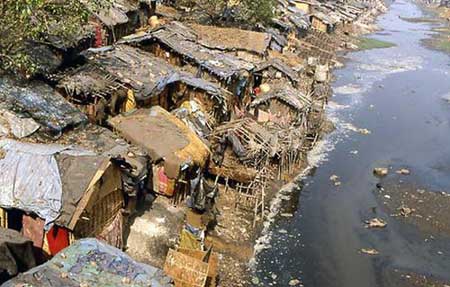LIFE OF SLUMS
60% of Mumbai's population survives at shantytowns and slums. There is a need to educate the slum children, the general health conditions of the slum dwellers are very poor. They are affected by several diseases like- malaria, dengue, typhoid, tuberculosis, cholera, pneumonia, hepatitis and not proper food and water occur diarrhea. Living in a slum area is a very challenging life, there is a need for primary healthcare in urban areas. Most of the places where slum dwellers live are unhygienic to their lives. For the millions of youth living in slums, daily life can be a grin. Kids start their lives in poverty front lines, without access to education, infrastructure or sanitation. They are subject to hunger, diseases, and thirst prematurely into adult responsibilities. It is a common assumption that slum kids spend their time doing menial jobs and not going to schools, and depend largely on charity to be able to achieve a better life.
While India's economy continues to boom since the last so many decades and Swatch Bharat Abhiyan( Clean India Mission) entering into a second year, it's 360 million poorest citizens remain among those living in some of the most dilapidated conditions in the world. The slums have become the indispensable and dark side of our country, which we can't boast of. It's so ironical that Delhi's slum(all over India) are the abode lakhs of people whose work makes the lives of its better-off citizens easier and comfortable but they themselves are forced to live in worst of conditions. They don't even have access to a basic need like functional toilets, breeding indignity, and infections in their daily lives. 'Behind the Beautiful Forever's life in an urban slum can be full of squalor and deprivations. This time at Indian slum has not been obscured but make India lovely team needed to get the early aid content as to what the real world is like at that trouble sort of conditions and it chooses to visit Lalbagh slum area near Azadpur which is just a few kilometers away from prestigious North campus of Delhi University. Lalbagh is Delhi's largest slum having a population of more than 3 lakhs and distributed around the area of only one kilometer.
60% of Mumbai's population survives at shantytowns and slums. There is a need to educate the slum children, the general health conditions of the slum dwellers are very poor. They are affected by several diseases like- malaria, dengue, typhoid, tuberculosis, cholera, pneumonia, hepatitis and not proper food and water occur diarrhea. Living in a slum area is a very challenging life, there is a need for primary healthcare in urban areas. Most of the places where slum dwellers live are unhygienic to their lives. For the millions of youth living in slums, daily life can be a grin. Kids start their lives in poverty front lines, without access to education, infrastructure or sanitation. They are subject to hunger, diseases, and thirst prematurely into adult responsibilities. It is a common assumption that slum kids spend their time doing menial jobs and not going to schools, and depend largely on charity to be able to achieve a better life.
While India's economy continues to boom since the last so many decades and Swatch Bharat Abhiyan( Clean India Mission) entering into a second year, it's 360 million poorest citizens remain among those living in some of the most dilapidated conditions in the world. The slums have become the indispensable and dark side of our country, which we can't boast of. It's so ironical that Delhi's slum(all over India) are the abode lakhs of people whose work makes the lives of its better-off citizens easier and comfortable but they themselves are forced to live in worst of conditions. They don't even have access to a basic need like functional toilets, breeding indignity, and infections in their daily lives. 'Behind the Beautiful Forever's life in an urban slum can be full of squalor and deprivations. This time at Indian slum has not been obscured but make India lovely team needed to get the early aid content as to what the real world is like at that trouble sort of conditions and it chooses to visit Lalbagh slum area near Azadpur which is just a few kilometers away from prestigious North campus of Delhi University. Lalbagh is Delhi's largest slum having a population of more than 3 lakhs and distributed around the area of only one kilometer.
















